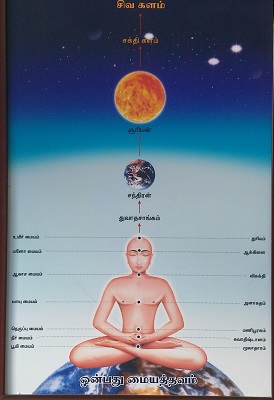Kuk Sul Hapkido Martial Arts
BE KIND, BE THRIFTY, BE HUMBLE

Raja Yoga
Raja means "imperial or royal," and Raja yoga (lit. Royal Yoga)
is meditation route to Self-Realization .
Raja yoga is the practice of yoga sketched by Patanjali in his Yoga Sutras. Raja yoga
sometimes referred to as Ashtanga (eight-limbed) yoga since there are
eight parts to the path to which one must focus. Raja yoga
emphasizes
mainly with the development of the mind using meditation to further one's knowledge
with reality and finally attain liberation.
Raja Yoga meditation is the practice by which
the student focus upon one point in order to incorporate intense attention, therefore
holding attention stable. All disruption and distractions are effectively closed out,
and meditation continues.
The basis for attaining an experience in raja yoga meditation in to understand the self
and the mind.
With meditation and concentration, one can strengthen and sharpen his or her intellect.
The end result is a continuous state of well being. If we are able to comprehend the
self as the source of energy that generates our feelings, then the following will become
our aims.
Become conscious of our state of mind and of the thoughts that flows into the mind from
our subconscious-mind .Strengthen the intellect so that the person can distinguish and
thus only allow positive and peaceful thoughts to flow into the mind.
Through this process of self development the individual develops more control
over the mind.
Eight limbs of Ashtanga Yoga The eight limbs of Ashtanga Yoga are: Yama - Code of conduct - self-restraint Niyama - religious observances - commitments to practice, such as study and devotion Asana - integration of mind and body through physical activity Pranayama - regulation of breath leading to integration of mind and body Pratyahara - abstraction of the senses, withdrawal of the senses of perception from their objects Dharana - concentration, one-pointedness of mind Dhyana - meditation (quiet activity that leads to samadhi) Samadhi - the quiet state of blissful awareness, superconscious state Yama Yama consists of five parts: Ahimsa (non-violence), Satya (truthfulness), Asteya (not stealing), Brahmacharya (celibacy), and Aparigraha (non-covetousness) . Ahimsa is perfect harmlessness and positive love also. This removes the brutal nature in man and strengthens the will. Niyama Asana Any easy, steady, comfortable pose is Asana. Asanas steady the body. Posture is mastered by releasing tension and meditation on the unlimited. Pranayama Pranayama checks the outgoing tendencies of the mind. Pratyahara Pratyahara gives inner spiritual strength. It removes all sorts of distractions. It develops will-power. Dharana Real Yoga starts from concentration. Concentration merges into meditation. Meditation ends in Samadhi. Retention of breath, Brahmacharya, Satvic (pure) food, seclusion, silence, Satsanga (being in the company of a guru), and not mixing much with people are all aids to concentration. Concentrate on Trikuti (the space between the two eyebrows) with closed eyes is preferred. The mind can be easily controlled, as this is the seat for the mind Dhyana Dhyana in Hinduism and Dhyana Sleep, tossing of mind, attachment to objects, subtle desires and cravings, laziness, lack of Brahmacharya, gluttony are all obstacles in meditation. Reduce your wants. Cultivate dispassion. You will have progress in Yoga. Vairagya thins out the mind. Do not mix much. Do not talk much. Do not walk much. Do not eat much. Do not sleep much. Do not exert much. Never wrestle with the mind during meditation. Do not use any violent efforts at concentration. If evil thoughts enter your mind, do not use your will force in driving them. You will tax your will. You will lose your energy. You will fatigue yourself. The greater the efforts you make, the more the evil thoughts will return with redoubled force. Be indifferent. Become a witness of those thoughts. Substitute divine thoughts. They will pass away. Never miss a day in meditation. Regularity is of paramount importance. When the mind is tired, do not concentrate. Do not take heavy food at night. The mind passes into many conditions or states as it is made up of three qualities-Sattva, Rajas and Tamas. Kshipta (wandering), Vikshipta (gathering), Mudha (ignorant), Ekagra (one-pointed), and Nirodha (contrary) are the five states of the mind. By controlling the thoughts the Sadhaka attains great Siddhis. He becomes an adept. He attains Asamprajnata Samadhi or Kaivalya. Do not run after Siddhis. Siddhis are great temptations. They will bring about your downfall. A Raja Yogi practises Samyama or the combined practice of Dharana, Dhyana and Samadhi at one and the same time and gets detailed knowledge of an object. Control the mind by Abhyasa (practice) and Vairagya (dispassion). Any practice which steadies the mind and makes it one-pointed is Abhyasa. Dull Vairagya will not help you in attaining perfection in Yoga. You must have Para Vairagya or Theevra Vairagya, intense dispassion. Samadhi Meditation on OM with Bhava and its meaning removes obstacles in Sadhana and helps to attain Samadhi. Avidya (ignorance), Asmita (egoism), Raga-Dvesha (likes and dislikes), Abhinivesha (clinging to mundane life) are the five Kleshas or afflictions. Destroy these afflictions. You will attain Samadhi. Samadhi is of two kinds: Savikalpa, Samprajnata or Sabija; and Nirvikalpa, Asamprajnata or Nirbija. In Savikalpa or Sabija, there is Triputi or the triad (knower, known and knowledge). The Samskaras are not burnt or fried. Savitarka, Nirvitarka, Savichara, Nirvichara, Sasmita and Saananda are the different forms of Savikalpa Samadhi. In Nirbija Samadhi or Asamprajnata Samadhi there is no triad. A Bhakta gets Bhava-Samadhi, a Jnani gets Badha-Samadhi, a Raja Yogi gets Nirodha Samadhi. Results Practice of these precepts is said to result in a state in which one's behavior spontaneously follows the five ethical precepts (Yamas): Ahimsa - refraining from injury (non-life supporting action) satya - truthfulness asteya - freedom from stealing bramacharya - living within the Self (moderation; abstinence) aparigraha - freedom from attachment to possessions |